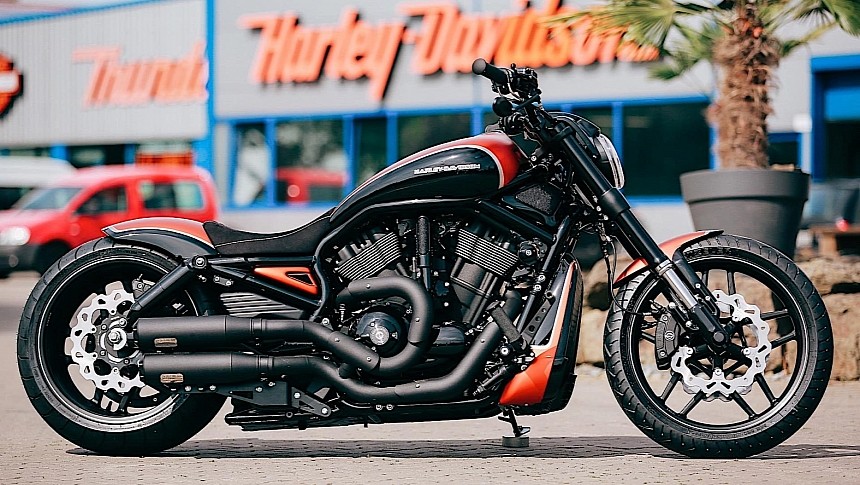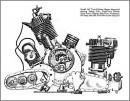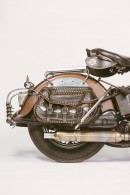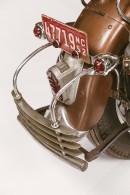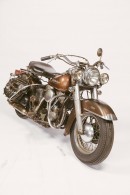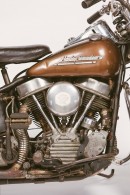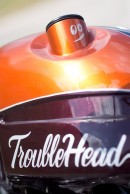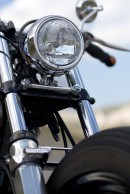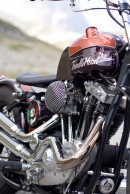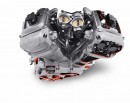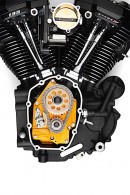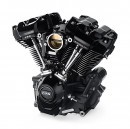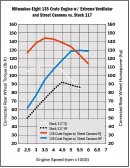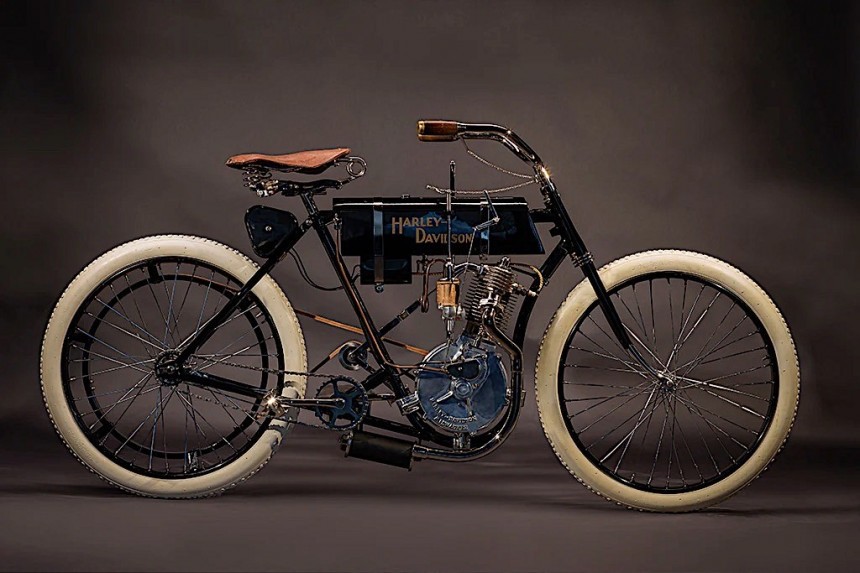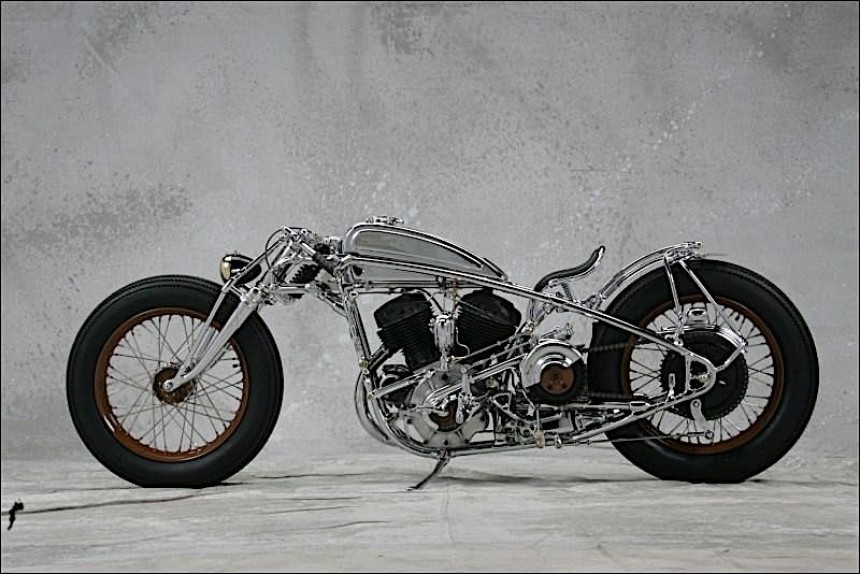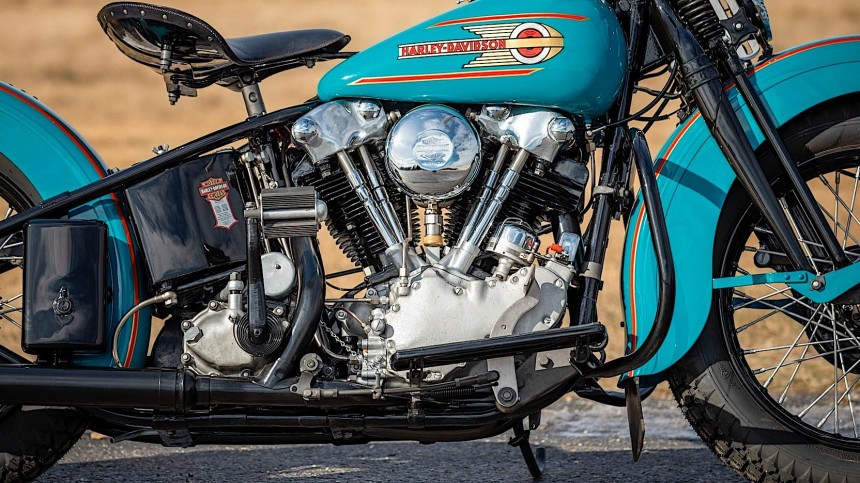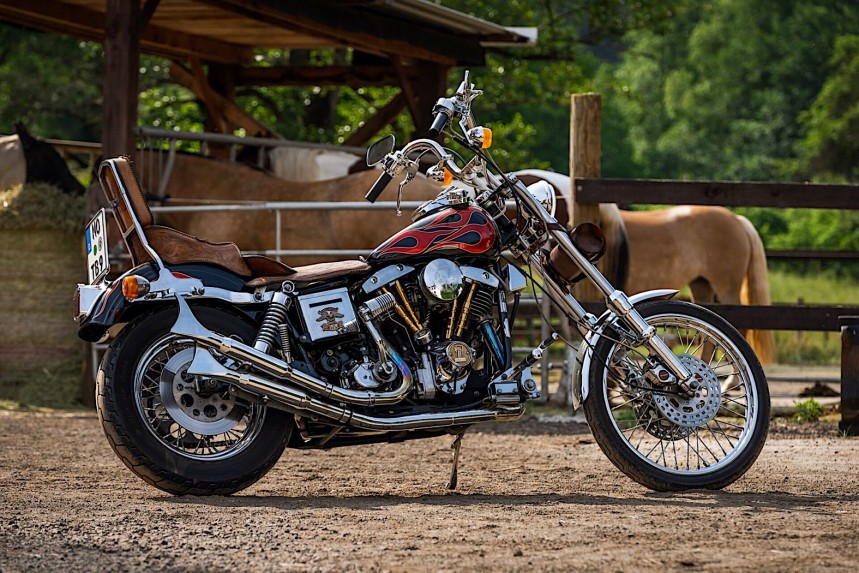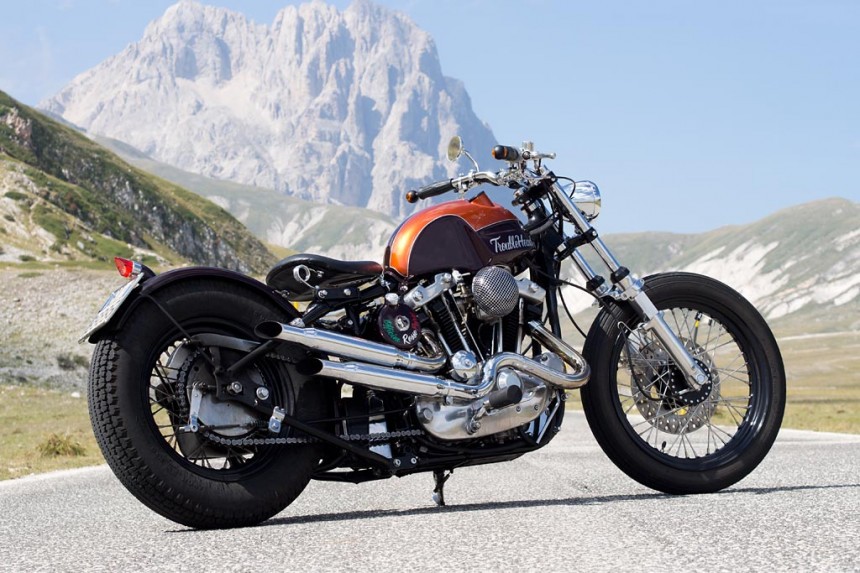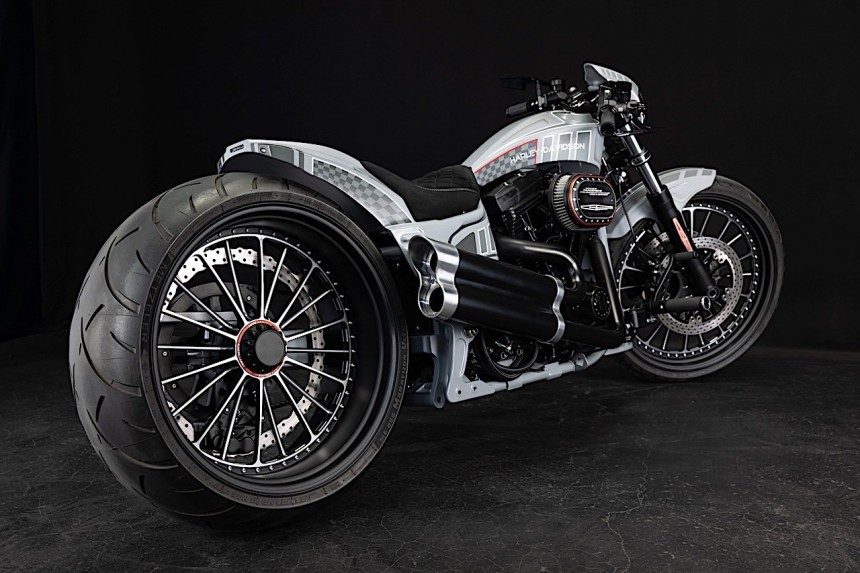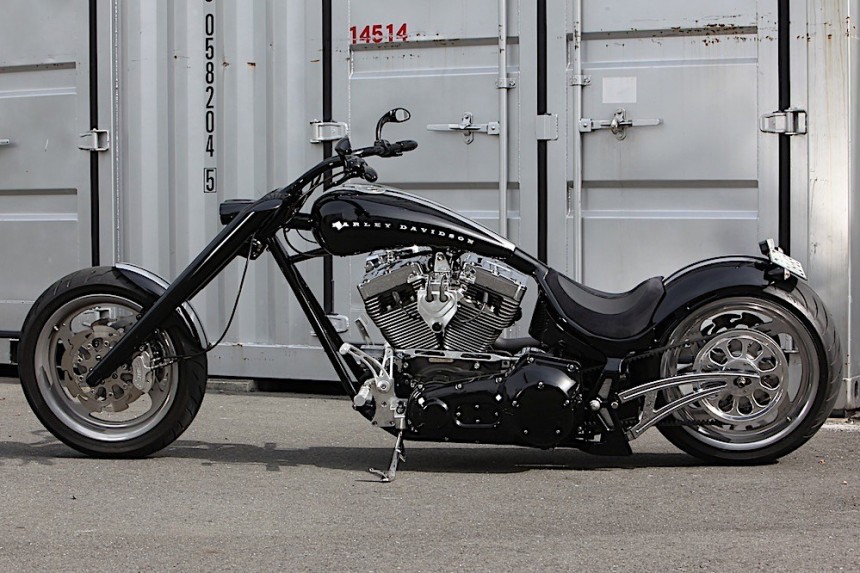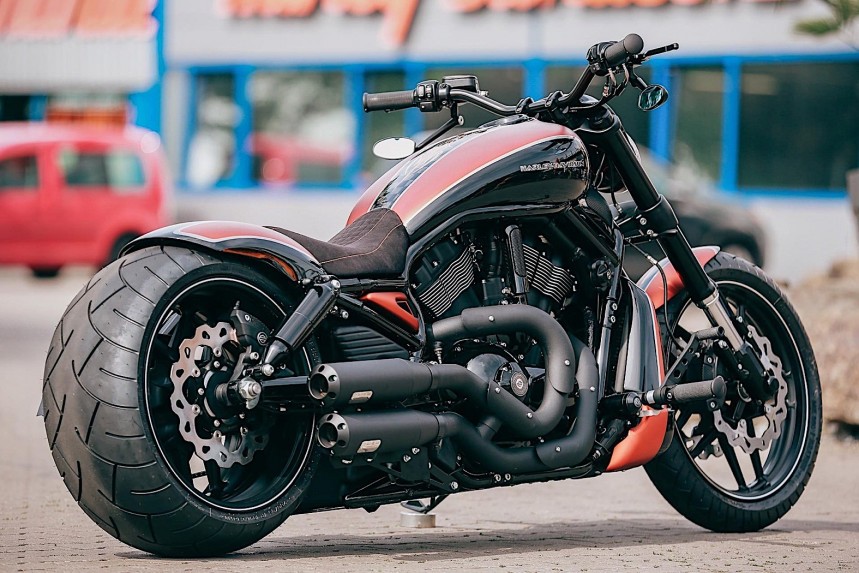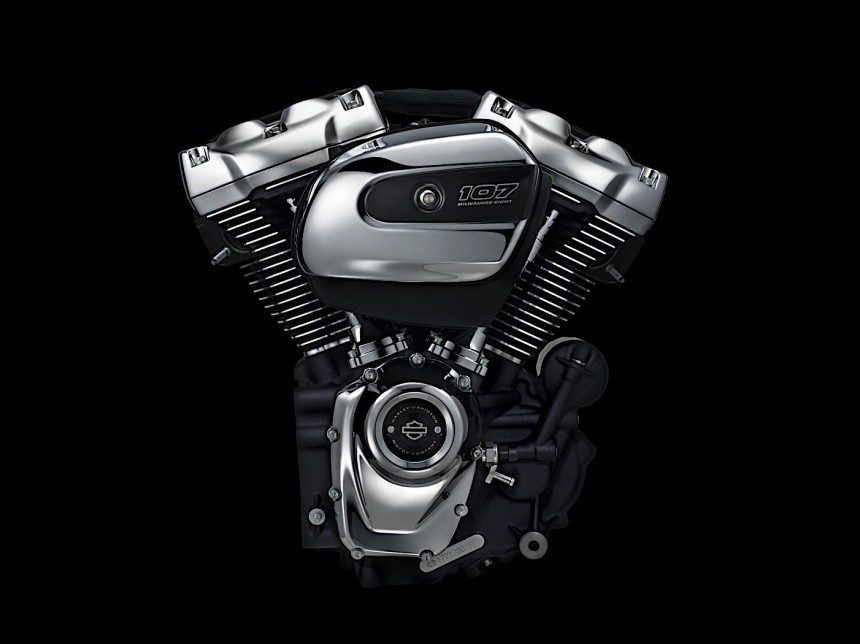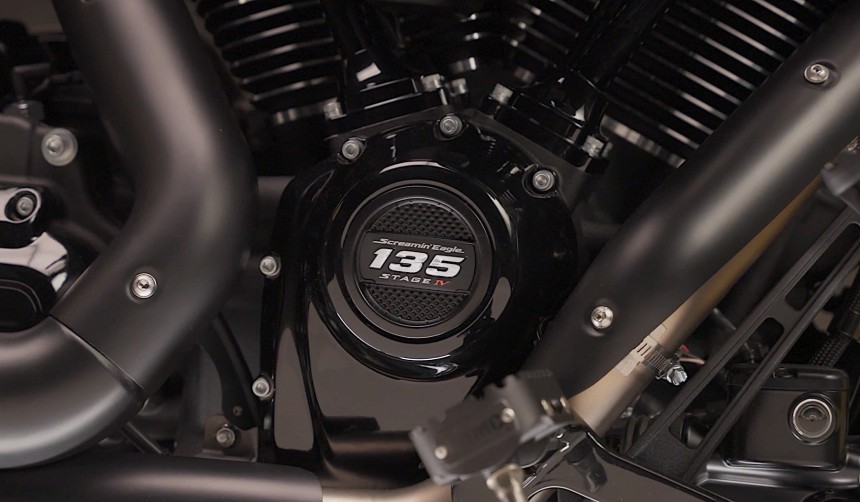For exactly 120 years human society has had an undeniably important companion as it moves forward through time: Harley-Davidson. In the 12 decades that have passed since its inception, the American company has grown far beyond the limits of a business and has become a way of life, a symbol, and, at times, a trendsetter in technology.
The century+ of Harley presence in this world brought with it not only incredible motorcycles that will probably be remembered forever by our species, but also components that have devastated the competition, inspired its followers, and, every now and then, opened the doors for technological advancements.
The engines Harley has made over the years are some of the most important such components. At the heart of any self-powered machine, the various versions of this type of hardware generally mean, for Harley and its army of followers, a lot more than what any other engine means for any other car and bike lovers.
Unlike when it comes to Harley motorcycle models, where things can get a bit confusing at times, the history, timeline and importance of Harley-Davidson engines is relatively clear and simple. However, if you're not familiar with the brand, you could be a bit surprised by the fact that 120 years of motorcycle models translate into just a few engine families.
Below, you'll find a list of the most important such tech Harley came up with. We'll start, of course, with the first bike and engine made all those years ago, and end with the most recent Harley engine to be launched by the time this piece was published. So bear with us until the end.
Back in 1903, when William S. Harley and Arthur Davidson rolled out their first motorcycle prototype, they used a tiny-compared-with-what-we-have-today engine. It was just 10ci in displacement (167cc), and cranked out a puny two-horsepower.
It wasn't entirely the invention of the two men, as it was built with inspiration taken from the most successful motorized contraption in Europe in the late 1890s and early 1900s, the De Dion-Bouton tricycle. That meant we were dealing with a four-stroke, single-cylinder piece of tech that had no clutch nor a transmission.
Although it clearly worked, the engine of course was far below what both Harley and Davidson were hoping for, so one year after their first bike, the Model 1, rolled out, the engine's size was increased to more than double the initial capacity.
Technically, the first-ever Harley engine powered bikes only for just two years, until 1905, but the family of single-cylinder engines it was part of, intake over exhaust (IOE or F-heads), stayed in production in one form or another up until 1929.
Officially, the era of F-heads started in 1911. By that time the company the two Americans were birthing was large enough to accommodate a larger offering when it comes to powerplants, so these F-heads came in two sizes, namely 61ci and 74ci (1,000cc and 1,210cc). The largest version of the engine had an output of 24 hp.
Unlike the version of the F-head we discussed earlier, these ones were not single-cylinder, but something we now know as a v-twin, using two cylinders for everyday operation, a configuration Harley had introduced earlier in 1909.
It was a design widely used back then both by motorcycle makers (including Harley rival Indian), and also carmakers like Willys and Rolls-Royce (although, in this case, we were talking about more cylinders than just two).
Whereas up until 1929 Harley's engine did not wear a specific name, and generally only a designation dictated by its construction, the turn of the decade would bring with it customers' habit of naming powerplants after the distinctive shape of their cylinder heads, rocker covers, or some other physical aspect.
The Flathead is the first example of such unofficial naming that stuck. The engine is known as such on account of the flat-topped cylinder heads. They too equipped with side valves, they were used in Harley motorcycles at first in a 45ci (737cc) size, and later grew to as much as 74ci. Later in the breed's life an even larger engine, 80ci (1,311cc), was introduced. In this largest incarnation, the engine was capable of delivering as much as 34 horsepower.
For use in motorcycles Harley didn't rely on the Flathead for very long. Two-wheelers dropped it around in 1952, yet the design kept pressing on in the Servi-Car, the precursor of today's Harley trikes, until 1973, as the only engine option available.
At about the same time the Flathead was enjoying its prime years, Harley brought forth something the industry and fans ended up referring to as the Knucklehead. This one was nicknamed so on account of its rocker boxes, which to some eyes seem to resemble the knuckles of a fist.
Whereas the Flathead was a valve-in-block engine, this new breed of V-twin came with an overhead valve (hence the OHV moniker it's also known under), the first ever in such a configuration in Harley's engine design, and such an evolution that it would grow to completely replace the Flathead.
The engine was first and foremost on a bike that would get to be known as the EL. In this application, it was offered in both 61ci and 74 ci versions, developing 53 horsepower from the largest version.
Having survived the ordeals of the Great Depression together with rival Indian, Harley was engaged in the 1930s - 1950s in an all-out offensive in the motorcycle segment, and with that came a much wider choice of engines than ever before. Aside from the Panhead and Knucklehead, another major launch of that era came in the form of the Panhead.
Named so because of the rocker covers that looked like average pans, the engine was introduced in 1948 in two variants, 61ci and 74ci. It officially came as a replacement for the Knucklehead and was used primarily on the EL, FL, and FLH models.
In various shapes and sizes this design still is in use today, despite Harley having stopped making it in 1965. Current Panhead engines come from third-party producers and are mostly used in custom builds, not in small part because it's seen by some as the most attractive Big Twin made in Milwaukee, in terms of both engineering and styling.
Whereas the Panhead is the most attractive of Harley Big Twin engines, the Shovelhead can easily be considered one of the most successful. Its name takes after the rocker covers again because in this case they resemble literal coal shovels placed upside down.
The powerplant came into the scene in two variants, 74ci and 80ci, and its main goal was to provide more power for the increasingly heavy bikes the Milwaukee company was making. That translated into power levels as high as 65 horsepower.
The Panhead is the last engine Harley developed with no assistance from computers, and even if it didn't come without issues, it remains one of the most important engines made by Harley, powering all the company's Big Twins during its years on the market.
The last in the series of Harley-Davidson engines to be called something-head was the Ironhead. Introduced in 1952, it became the beating heart in the frames of the motorcycles the world has come to know as the Sportsters.
The unit got this nickname because it had cylinder heads made from iron instead of aluminum. It was a two-cylinder V-twin affair that in its early days was capable of developing 40 hp and pushing the bikes to a top speed of 100 mph (161 kph).
Initially, the engine came with a displacement of 54ci (883cc), it was taken to 61ci (1,000cc) in 1972, the only time the powerplant was significantly upgraded.
One of the most famous Harley engines ever made came at about the time the Ironhead was singing its swansong. It's the Evolution I am talking about, also known as the Evo among true enthusiasts.
The engine was launched in 1984, and it was meant to power the then-new breed of Milwaukee two-wheelers, the Softail. Technically an evolution of the Shovelhead, it came with more torque but at the same time with less of an appetite for fuel.
From 1986 the Evolution migrated to the Sportster family as well, and it even went on to power the products of (somewhat) rival Buell.
Of all the engines we've listed so far the Evolution is the one to be discontinued closest to our time. Harley pulled the plug on it in 1999 in the Softail range, and did the same for the Sportster in 2018. During its time on the market it generally came in sizes ranging from 54 ci to 74ci. In the Big Twin applications, its size grew to an impressive 82ci (1,340 cc).
Despite betting a lot on the Evolution engine and keeping it for long years in production, the hardware was not without issues. It was prone to structural weakness and even leakages, and there was also a need for a bit more power in the frames of bikes of the Softail and touring ranges.
That's how the Twin Cam came to be in 1998 and was to be made available until its discontinuation in 2017 in sizes ranging from 88ci (1,450cc) to a massive 110ci (1,801cc) for the exquisite CVO models.
The Twin Cam was quite successful and is still present in a lot of the Harley bikes that roam our streets today. The bike maker is even offering official parts for it, including kits that can take the largest displacement even higher, to 117cc (1,917cc).
Back in 2001 Harley-Davidson did something unexpected and decided to enter the muscle bike segment with a new range of bikes called V-twin racing street custom (VRSC). And with the new family of bikes came the need for a new kind of engine, which Harley developed together with Porsche Engineering.
And it marked quite the departure from how Harley was used to doing things. Instead of the usual 45-degree configuration, this one came at 60 degrees. The powerplant had a displacement of 69ci (1,131cc) and, while controlled by means of a five-speed transmission, it developed up to 115 hp. Later down the line, a 76ci (1,245cc) was introduced and power grew to as much as 125 hp.
The engine technically died out in 2017, with the discontinuation of the V-Rod family, but its legacy runs strong even today. That's because VRSCs are some of the most customized Harley-Davidson bikes ever made, with scores of incredible examples being kept relevant even now by shops around the world.
The engine took its name after the place it was made and the number of valves in the two cylinders. At launch the engine came in two displacement options, 107ci (1,750cc) and 114ci (1,750cc) – the latter one intended for the CVO models. In 2019 the Milwaukee-Eight 117 was born (1,917cc).
The same CVO models I mentioned earlier got a major boost in power and appeal earlier in 2023, when Harley let loose the new Milwaukee-Eight VVT 121 engine. Destined for the frames of the brand-new CVO versions of the Street Glide and Road Glide announced the same year, the unit produces 9.5 percent more horsepower and eight percent more torque than the 117, meaning a total of 115 hp and 189 Nm of torque.
What the engine tries to make great is the Variable Valve Timing (VVT) tech that helps cut the fuel consumption for a bit, anywhere between three and five percent compared to a standard drive cycle engine.
The engine was initially introduced as a 76ci (1,250cc) version only, but in the two years that have passed since a smaller version made it into the wild, the 59ci (975cc). This one was initially intended for a new bike called Bronx, but that was delayed indefinitely so the engine is now used solely in the Nightster model.
Just like the Revolution made with Porsche, the Max comes in a 60-degree configuration and develops from 89 hp for the smaller variant to 121 hp for the larger one.
Back in March of 2023, Harley let loose the largest and most powerful street engine it ever made. It's called Screamin' Eagle 135 Stage IV, meaning it's at the top of the Harley crate engine offering and it's a 2.2-liter behemoth capable of developing a total of 130 horsepower. That's a huge 41 percent increase over the Milwaukee-Eight 117.
The powerplant is intended for Touring motorcycles produced after 2021, and it was built taking note of the lessons Harley learned during the MotoAmerica Mission King of the Baggers racing series.
Two versions of it are currently on the market, one for bikes equipped with an air/oil-cooled Milwaukee-Eight engine, and the other for the ones rocking twin-cooled powerplants from the same range.
As far as I know, at the time of writing, Harley-Davidson is not preparing anything spectacular on the engine front in the near future, so for a while at least the above engines are all the motorbike maker has to offer in this field.
The engines Harley has made over the years are some of the most important such components. At the heart of any self-powered machine, the various versions of this type of hardware generally mean, for Harley and its army of followers, a lot more than what any other engine means for any other car and bike lovers.
Unlike when it comes to Harley motorcycle models, where things can get a bit confusing at times, the history, timeline and importance of Harley-Davidson engines is relatively clear and simple. However, if you're not familiar with the brand, you could be a bit surprised by the fact that 120 years of motorcycle models translate into just a few engine families.
Below, you'll find a list of the most important such tech Harley came up with. We'll start, of course, with the first bike and engine made all those years ago, and end with the most recent Harley engine to be launched by the time this piece was published. So bear with us until the end.
Model 1 (1903)
It wasn't entirely the invention of the two men, as it was built with inspiration taken from the most successful motorized contraption in Europe in the late 1890s and early 1900s, the De Dion-Bouton tricycle. That meant we were dealing with a four-stroke, single-cylinder piece of tech that had no clutch nor a transmission.
Although it clearly worked, the engine of course was far below what both Harley and Davidson were hoping for, so one year after their first bike, the Model 1, rolled out, the engine's size was increased to more than double the initial capacity.
Technically, the first-ever Harley engine powered bikes only for just two years, until 1905, but the family of single-cylinder engines it was part of, intake over exhaust (IOE or F-heads), stayed in production in one form or another up until 1929.
F-head (1911 - 1929)
Unlike the version of the F-head we discussed earlier, these ones were not single-cylinder, but something we now know as a v-twin, using two cylinders for everyday operation, a configuration Harley had introduced earlier in 1909.
It was a design widely used back then both by motorcycle makers (including Harley rival Indian), and also carmakers like Willys and Rolls-Royce (although, in this case, we were talking about more cylinders than just two).
Flathead (1929 - 1973)
The Flathead is the first example of such unofficial naming that stuck. The engine is known as such on account of the flat-topped cylinder heads. They too equipped with side valves, they were used in Harley motorcycles at first in a 45ci (737cc) size, and later grew to as much as 74ci. Later in the breed's life an even larger engine, 80ci (1,311cc), was introduced. In this largest incarnation, the engine was capable of delivering as much as 34 horsepower.
For use in motorcycles Harley didn't rely on the Flathead for very long. Two-wheelers dropped it around in 1952, yet the design kept pressing on in the Servi-Car, the precursor of today's Harley trikes, until 1973, as the only engine option available.
Knucklehead (1936 - 1948)
Whereas the Flathead was a valve-in-block engine, this new breed of V-twin came with an overhead valve (hence the OHV moniker it's also known under), the first ever in such a configuration in Harley's engine design, and such an evolution that it would grow to completely replace the Flathead.
The engine was first and foremost on a bike that would get to be known as the EL. In this application, it was offered in both 61ci and 74 ci versions, developing 53 horsepower from the largest version.
Panhead (1948 - 1965)
Named so because of the rocker covers that looked like average pans, the engine was introduced in 1948 in two variants, 61ci and 74ci. It officially came as a replacement for the Knucklehead and was used primarily on the EL, FL, and FLH models.
In various shapes and sizes this design still is in use today, despite Harley having stopped making it in 1965. Current Panhead engines come from third-party producers and are mostly used in custom builds, not in small part because it's seen by some as the most attractive Big Twin made in Milwaukee, in terms of both engineering and styling.
Shovelhead (1966 - 1984)
The powerplant came into the scene in two variants, 74ci and 80ci, and its main goal was to provide more power for the increasingly heavy bikes the Milwaukee company was making. That translated into power levels as high as 65 horsepower.
The Panhead is the last engine Harley developed with no assistance from computers, and even if it didn't come without issues, it remains one of the most important engines made by Harley, powering all the company's Big Twins during its years on the market.
Ironhead (1952 - 1986)
The unit got this nickname because it had cylinder heads made from iron instead of aluminum. It was a two-cylinder V-twin affair that in its early days was capable of developing 40 hp and pushing the bikes to a top speed of 100 mph (161 kph).
Initially, the engine came with a displacement of 54ci (883cc), it was taken to 61ci (1,000cc) in 1972, the only time the powerplant was significantly upgraded.
Evolution (1984 - 1999)
The engine was launched in 1984, and it was meant to power the then-new breed of Milwaukee two-wheelers, the Softail. Technically an evolution of the Shovelhead, it came with more torque but at the same time with less of an appetite for fuel.
From 1986 the Evolution migrated to the Sportster family as well, and it even went on to power the products of (somewhat) rival Buell.
Of all the engines we've listed so far the Evolution is the one to be discontinued closest to our time. Harley pulled the plug on it in 1999 in the Softail range, and did the same for the Sportster in 2018. During its time on the market it generally came in sizes ranging from 54 ci to 74ci. In the Big Twin applications, its size grew to an impressive 82ci (1,340 cc).
Twin Cam (1998 - 2017)
That's how the Twin Cam came to be in 1998 and was to be made available until its discontinuation in 2017 in sizes ranging from 88ci (1,450cc) to a massive 110ci (1,801cc) for the exquisite CVO models.
The Twin Cam was quite successful and is still present in a lot of the Harley bikes that roam our streets today. The bike maker is even offering official parts for it, including kits that can take the largest displacement even higher, to 117cc (1,917cc).
Revolution (2001 - 2017)
And it marked quite the departure from how Harley was used to doing things. Instead of the usual 45-degree configuration, this one came at 60 degrees. The powerplant had a displacement of 69ci (1,131cc) and, while controlled by means of a five-speed transmission, it developed up to 115 hp. Later down the line, a 76ci (1,245cc) was introduced and power grew to as much as 125 hp.
The engine technically died out in 2017, with the discontinuation of the V-Rod family, but its legacy runs strong even today. That's because VRSCs are some of the most customized Harley-Davidson bikes ever made, with scores of incredible examples being kept relevant even now by shops around the world.
Milwaukee-Eight (2016-present)
In the summer of 2016 Harley-Davidson launched the ninth engine in the line of Big Twin hardware. It's a powerplant we still see in use today, on a wide range of motorcycles: Street Glide, Road Glide, Electra Glide, Ultra, Road King, and even on the Freewheeler trike. Pretty much all Touring and Trike ranges have been powered by this powerplant from 2017 onwards.The engine took its name after the place it was made and the number of valves in the two cylinders. At launch the engine came in two displacement options, 107ci (1,750cc) and 114ci (1,750cc) – the latter one intended for the CVO models. In 2019 the Milwaukee-Eight 117 was born (1,917cc).
The same CVO models I mentioned earlier got a major boost in power and appeal earlier in 2023, when Harley let loose the new Milwaukee-Eight VVT 121 engine. Destined for the frames of the brand-new CVO versions of the Street Glide and Road Glide announced the same year, the unit produces 9.5 percent more horsepower and eight percent more torque than the 117, meaning a total of 115 hp and 189 Nm of torque.
What the engine tries to make great is the Variable Valve Timing (VVT) tech that helps cut the fuel consumption for a bit, anywhere between three and five percent compared to a standard drive cycle engine.
Revolution Max (2021 - present)
The newest engine type introduced by Harley-Davidson is the Revolution Max. It was born in 2021 to power the bike's maker entry in the adventure segment, the Pan America, but it was later expanded to include the new family of Sportsters.The engine was initially introduced as a 76ci (1,250cc) version only, but in the two years that have passed since a smaller version made it into the wild, the 59ci (975cc). This one was initially intended for a new bike called Bronx, but that was delayed indefinitely so the engine is now used solely in the Nightster model.
Just like the Revolution made with Porsche, the Max comes in a 60-degree configuration and develops from 89 hp for the smaller variant to 121 hp for the larger one.
Screamin' Eagle (present)
All of the engines listed above have made it into Harley motorcycles right off the factory floor, but there is a species of such hardware that's a bit harder to come by: the Screamin' Eagle crate engines. And these things were at the center of a major upgrade this year as well.Back in March of 2023, Harley let loose the largest and most powerful street engine it ever made. It's called Screamin' Eagle 135 Stage IV, meaning it's at the top of the Harley crate engine offering and it's a 2.2-liter behemoth capable of developing a total of 130 horsepower. That's a huge 41 percent increase over the Milwaukee-Eight 117.
The powerplant is intended for Touring motorcycles produced after 2021, and it was built taking note of the lessons Harley learned during the MotoAmerica Mission King of the Baggers racing series.
Two versions of it are currently on the market, one for bikes equipped with an air/oil-cooled Milwaukee-Eight engine, and the other for the ones rocking twin-cooled powerplants from the same range.
As far as I know, at the time of writing, Harley-Davidson is not preparing anything spectacular on the engine front in the near future, so for a while at least the above engines are all the motorbike maker has to offer in this field.
